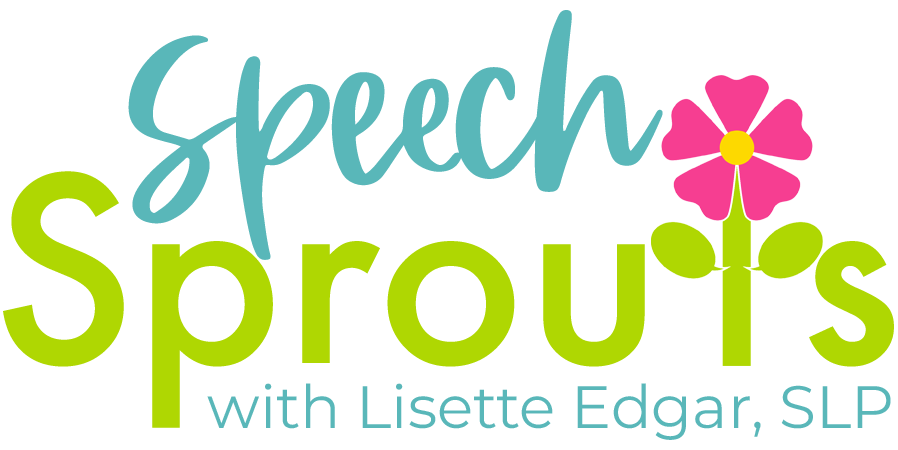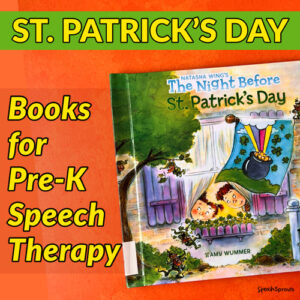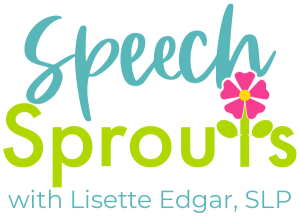
The OASES Stuttering Test-How to Capture More than Disfluencies

Are you measuring everything you need to for a complete stuttering assessment? I realized that my fluency assessment battery was missing a very important piece… a thorough look at how stuttering affected my student’s life…from my student’s perspective.
You may be like me. Yep… I took a case history, talked to parents, teachers, and the student about stuttering. I gave a stuttering test. I categorized and timed those stutters (not so easy sometimes!) and watched for secondary characteristics so I could score and obtain a severity rating.
But did I dig deep enough? I have to say, those measures alone left me less than completely confident in making clinical decisions for my student.
A review of the OASES stuttering test
The OASES™ or Overall Assessment of the Speaker’s Experience of Stuttering is a stuttering assessment that addresses exactly that- the overall impact stuttering has on the speaker… from the speaker’s point of view. The OASES™ was originally developed by speech-language pathologists Dr. J. Scott Yaruss and Dr. Robert W. Quesal for adults, and can now be used with children as young as seven.
This post is a review of the most recent version of the OASES™ copyrighted in 2010, 2016. Disclosure: I requested and received a copy of the OASES from Stuttering Therapy Resources without charge, so that I may review the test for the purposes of this post. The views and opinions in this post, however, are mine alone.
Stuttering tests like the SSI-4 tell us about the observable aspects of stuttering.
Documenting the frequency, duration, and type of observed stuttering, as well as any secondary characteristics, is, of course, part of a complete overall evaluation. You’ll obtain a severity rating, which is a rating of the observable stuttering events. Here’s the thing… a severity rating doesn’t give us enough information to understand how the speaker’s life is affected by his or her stuttering or what we need to do in therapy.
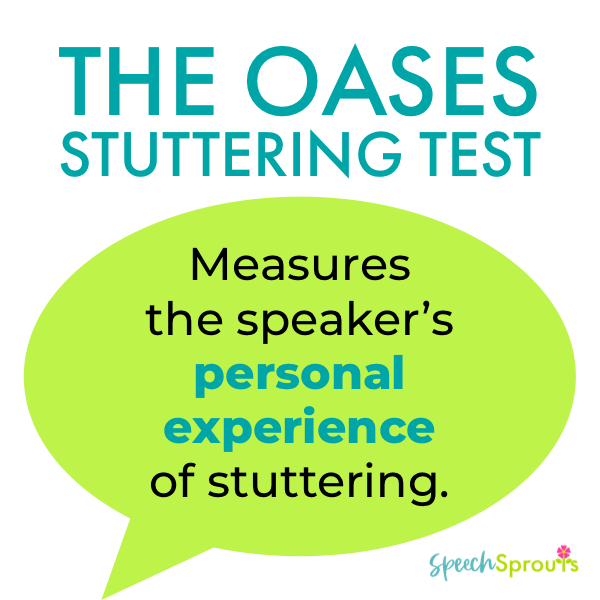
The OASES measures a speaker’s experience of stuttering which can tell us even more than a severity rating.
How a person perceives and reacts to their stuttering is very personal. The OASES goes below the surface to examine how stuttering affects the speaker’s everyday functioning, attitudes, and emotions, and measures the adverse impact of stuttering.
Not every person who stutters needs therapy, or might be ready for therapy. Learn more about that in this post: 3 Valuable Insights That Changed the Way I Assess and Treat Stuttering.
So how do you make those clinical decisions? The crux of the matter is how the speaker views the personal impact that stuttering has on their life. That’s where the OASES comes in.
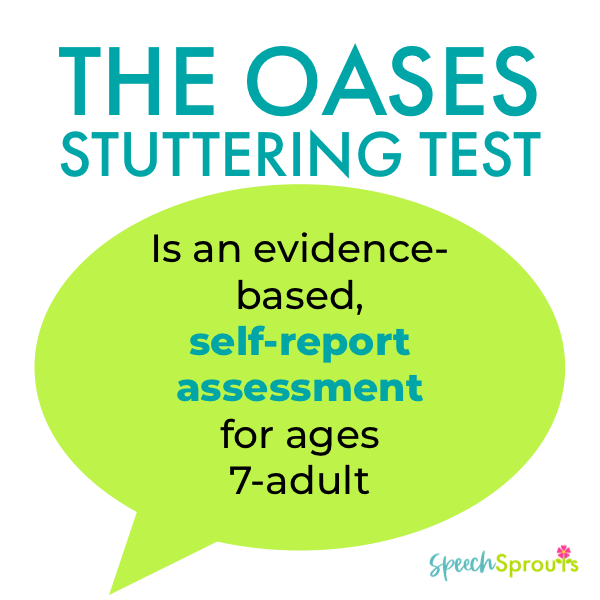
The OASES stuttering test is an evidence-based, self-report measure.
The OASES assesses the impact of stuttering for both children and adults.
Have you ever assessed a student who never stuttered in front of you? Or maybe rarely stutters in class, but parents report the student stutters a lot? I have. That may be because the child is hiding their stuttering, rarely speaking up in class, or changing what they want to say so they don’t stutter.
For a student like this, the impact of stuttering on his life is significant, but could possibly go unnoticed if he’s really good at hiding it.
I love that the OASES is a self-report assessment, making it especially helpful for a hard-to-assess student who hides their stuttering.
Who the OASES is for:
AGES: There are three separate protocols for the OASES stuttering test. School-Age: Ages 7-12, Teenage: Ages 13-17 and Adult. My understanding is that there is currently work being done to develop a version for young children, ages 3-6.
Today, I’ll be talking about using the OASES stuttering test to assess stuttering in school-age children and teens. There are more total questions for the teenage forms than school-age forms and each is designed with age-appropriate vocabulary.
LANGUAGES: The printed OASES response forms are available in English and Spanish, and in several other languages on a print-your-own basis.
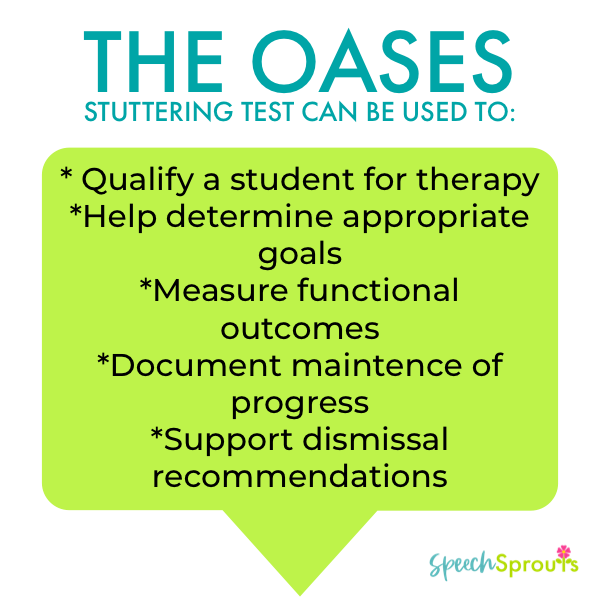
When to use the OASES:
There are several reasons you may want to give the OASES stuttering test:
- Identify adverse impact to qualify a student for services (valuable to document for educational impact!)
- Help in determining appropriate goals and where to focus therapy
- Measure functional outcomes when given as a pre and post-test for therapy.
- To measure whether a student on consult or who was dismissed has maintained progress or may need to resume direct services.
The OASES is a quick and easy stuttering test to give.
The amount of time you have to evaluate may be limited (especially in the schools), but I promise this assessment is easy to fit in and the information you’ll gather will be absolutely worth it.
MATERIALS: All you need is a pencil and a form to give this test.
No stopwatch, heavy binders or books to lug around… a huge plus!
ADMINISTRATION TIME: Giving the OASES takes approximately 15-20 minutes. There are 60 questions for school-age students, 80 questions for teenagers, and 100 questions for adults.
Because the OASES is a self-report instrument, readers can complete it on their own…independently.
You don’t need to read the questions to students unless they have difficulty reading. Be sure you’re available for questions, however, if there is something they don’t understand.
That’s awesome, anything that helps with the ever-present time crunch is a win!
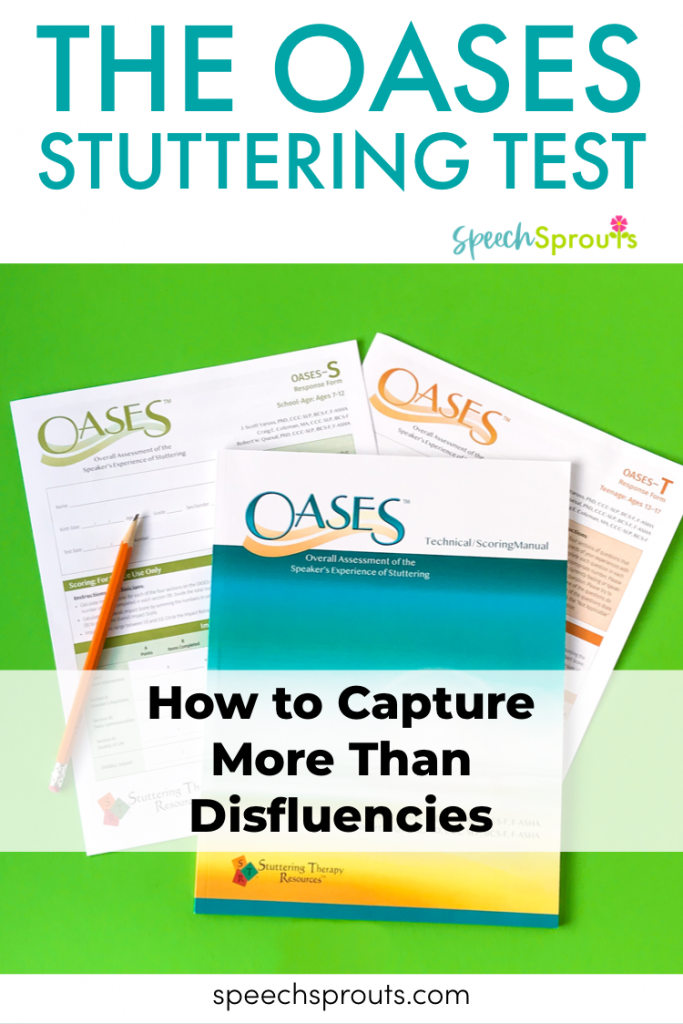
Here’s what you’ll learn about your student when you give the OASES stuttering test.
The response form is divided into four main areas:
- General Information – How much does your student know about stuttering and how do they generally feel about their speech? This information can help you know where to start with your student.
- Reactions to Stuttering – How does stuttering affect your student emotionally, such as embarrassment or frustration? How much anxiety do they feel in specific speaking situations? Do they react to their stuttering with muscle tension, avoidance, letting others speak for them?
- Communication in Daily Situations – Students report how easy or difficult speaking is for them in various situations and with various listeners. Really valuable for establishing therapy goals!
- Quality of Life – How does stuttering affect the person overall? Does stuttering hold them back from saying what they want to say and doing what they want to do?
Scoring and Interpretation
SCORING: Scoring is also quick and easy. The student rates each question on a scale of 1-5. You add the up points, divide by the number of questions completed and find the corresponding Impact Rating (from mild to severe impact) which is right on the response form.
The OASES is standardized and provides a numerical score, which helps you meet the requirements of some schools and insurance providers.
INTERPRETATION: The manual provides clear, easy-to-understand descriptions of each impact rating that will help you describe the impact of stuttering on your student, make clinical decisions, share with parents and teachers, and use to help justify and support eligibility or dismissal criteria. This is another huge time-saver when writing reports.
- Identifying emotions and anxiety related to stuttering
- Identifying avoidance behaviors
- Measuring how much stuttering interferes in daily communication.
- Measuring the negative impact of stuttering in overall quality of life…being able to do what do what he wants to do.
In summary, here’s why I highly recommend you add the OASES to your assessment toolbox.
- The OASES stuttering test is quick and easy to give and score!
- You’ll be able to measure the impact stuttering has on your student’s life as reported by the student!
- It helps you make data-driven decisions on whether to qualify a student for therapy services
- It provides excellent descriptions of how stuttering affects the student for each impact rating helping parents and teachers understand your recommendations.
- You’ll have so much more information to help you plan therapy and set goals.
- It’s an excellent tool to measure functional progress and guide decisions about when to dismiss.
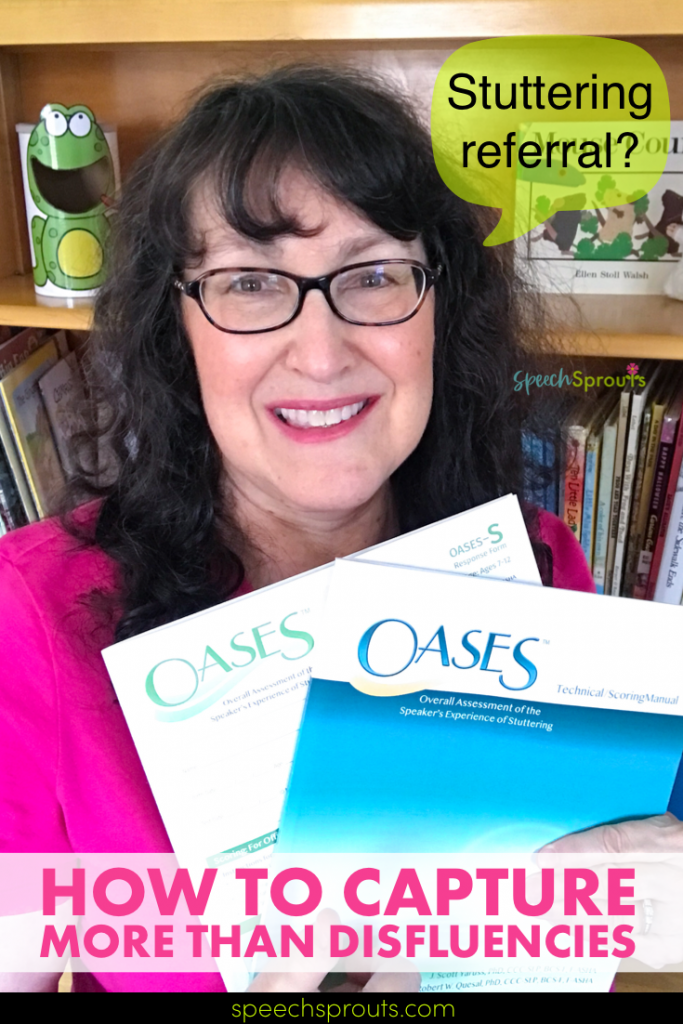
Read more posts about stuttering.
If you’ve made it to the bottom of the post, thank so you sooo much for your interest in learning more about providing quality assessments and therapy to our friends who stutter. You may enjoy these posts too:
Children Who Stutter and Bullying-6 Ways SLPs Can Help. This a guest post with lots of great tips by Dr. Scott Yaruss.
The OASES Stuttering Test-How to Capture More Than Disfluencies My review of the OASES Stuttering Assessment
Until next time my friends!

Share it:
- Read more about: Stuttering
